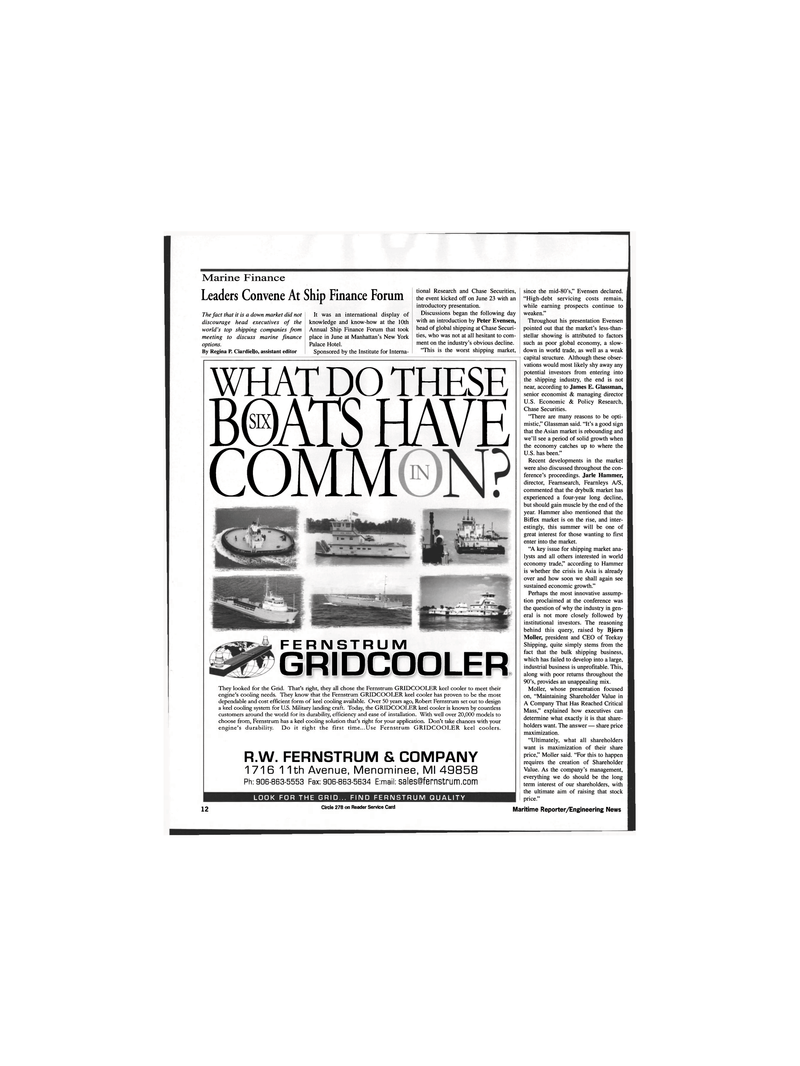
Page 12: of Maritime Reporter Magazine (August 1999)
Read this page in Pdf, Flash or Html5 edition of August 1999 Maritime Reporter Magazine
Marine Finance
Leaders Convene At Ship Finance Forum
The fact that it is a down market did not discourage head executives of the world's top shipping companies from meeting to discuss marine finance options.
By Regina P. Ciardiello, assistant editor
It was an international display of knowledge and know-how at the 10th
Annual Ship Finance Forum that took place in June at Manhattan's New York
Palace Hotel.
Sponsored by the Institute for Interna- tional Research and Chase Securities, the event kicked off on June 23 with an introductory presentation.
Discussions began the following day with an introduction by Peter Evensen, head of global shipping at Chase Securi- ties, who was not at all hesitant to com- ment on the industry's obvious decline. "This is the worst shipping market,
WHAT DO THESE B6ATS HAVE
COMM
FERNSTRUM GRIDCOOLER
They looked for the Grid. That's right, they all chose the Fernstrum GRIDCOOLER keel cooler to meet their engine's cooling needs. They know that the Fernstrum GRIDCOOLER keel cooler has proven to be the most dependable and cost efficient form of keel cooling available. Over 50 years ago, Robert Fernstrum set out to design a keel cooling system for U.S. Military landing craft. Today, the GRIDCOOLER keel cooler is known by countless customers around the world for its durability, efficiency and ease of installation. With well over 20,000 models to choose from, Fernstrum has a keel cooling solution that's right for your application. Don't take chances with your engine's durability. Do it right the first time...Use Fernstrum GRIDCOOLER keel coolers.
R.W. FERNSTRUM & COMPANY 1716 11th Avenue, Menominee, Ml 49858
Ph: 906-863-5553 Fax: 906-863-5634 E:mail: [email protected]
LOOK FOR THE GRID... FIND FERNSTRUM QUALITY 12 Circle 278 on Reader Service Card since the mid-80's," Evensen declared. "High-debt servicing costs remain, while earning prospects continue to weaken."
Throughout his presentation Evensen pointed out that the market's less-than- stellar showing is attributed to factors such as poor global economy, a slow- down in world trade, as well as a weak capital structure. Although these obser- vations would most likely shy away any potential investors from entering into the shipping industry, the end is not near, according to James E. Glasstnan, senior economist & managing director
U.S. Economic & Policy Research,
Chase Securities. "There are many reasons to be opti- mistic," Glassman said. "It's a good sign that the Asian market is rebounding and we'll see a period of solid growth when the economy catches up to where the
U.S. has been."
Recent developments in the market were also discussed throughout the con- ference's proceedings. Jarle Hammer, director, Fearnsearch, Fearnleys A/S, commented that the drybulk market has experienced a four-year long decline, but should gain muscle by the end of the year. Hammer also mentioned that the
Biffex market is on the rise, and inter- estingly, this summer will be one of great interest for those wanting to first enter into the market. "A key issue for shipping market ana- lysts and all others interested in world economy trade," according to Hammer is whether the crisis in Asia is already over and how soon we shall again see sustained economic growth."
Perhaps the most innovative assump- tion proclaimed at the conference was the question of why the industry in gen- eral is not more closely followed by institutional investors. The reasoning behind this query, raised by Bjorn
Moller, president and CEO of Teekay
Shipping, quite simply stems from the fact that the bulk shipping business, which has failed to develop into a large, industrial business is unprofitable. This, along with poor returns throughout the 90's, provides an unappealing mix.
Moller, whose presentation focused on, "Maintaining Shareholder Value in
A Company That Has Reached Critical
Mass," explained how executives can determine what exactly it is that share- holders want. The answer — share price maximization. "Ultimately, what all shareholders want is maximization of their share price," Moller said. "For this to happen requires the creation of Shareholder
Value. As the company's management, everything we do should be the long term interest of our shareholders, with the ultimate aim of raising that stock price."
Maritime Reporter/Engineering News

 11
11

 13
13
